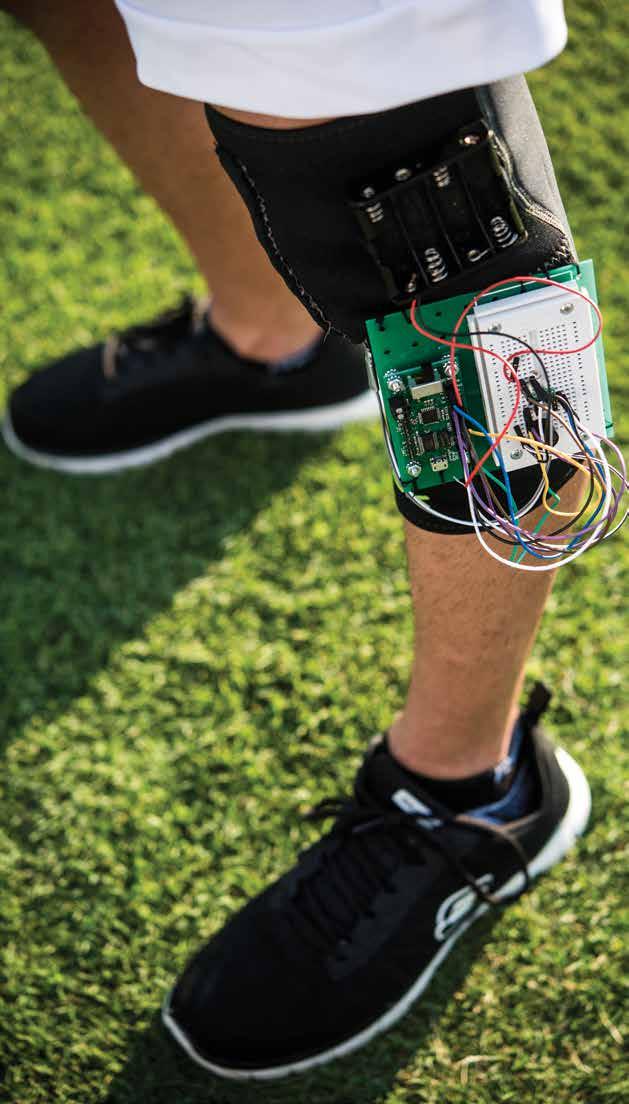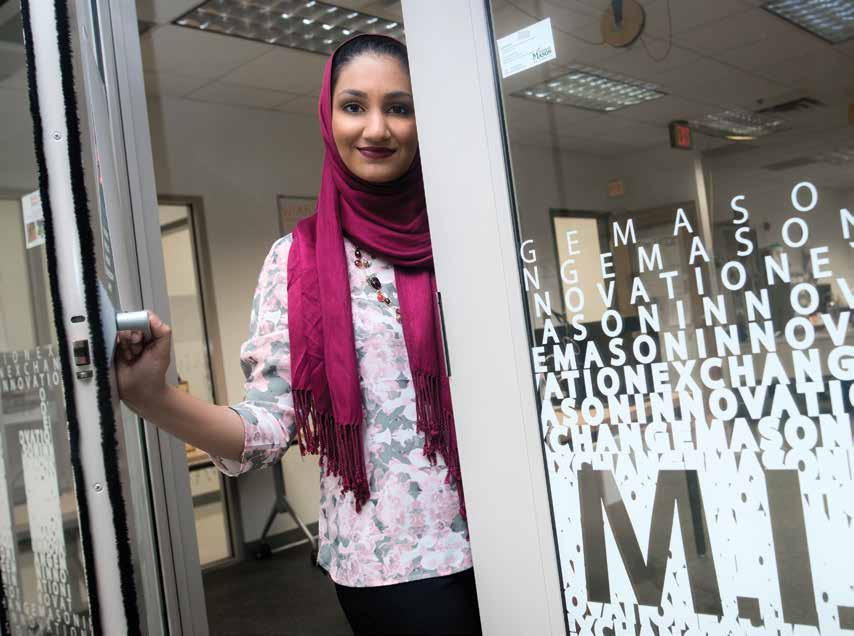
3 minute read
Engineering Students’ Device Helps Athletes ‘Stay in the Game’
By Martha Bushong, Director of Communications
Do you know someone with a torn anterior cruciate ligament (ACL)? If you answered yes, it’s not a surprise. According to NCAA statistics, 1 in 13 female athletes experience a torn ACL. It’s an epidemic that few people are talking about.
Few that is, except for an enterprising team of students in the Volgenau School of Engineering’s Systems Engineering Program. Even though each of these students is an athlete, the project tested their problem-solving abilities, not their physical prowess.
Team members Amr Attyah, Maribeth Burns, Sam Miller, and Andrew Tesnow, all systems engineering majors, started by building a simulation model of the knee. Tey then introduced failure mechanisms—fve noncontact and three contact ones. Te ACL can be torn through contact (getting hit in the knee) or through noncontact means (turning weirdly or landing a jump incorrectly). Tis engineering team focused on ACL tears due to low knee fexion angle, the angle between the femur and the shin.
“Everyone thinks ACL tears are the result of contact, but 70 percent are the result of noncontact movement, like landing from a jump, stopping short, or moving quickly from side-toside,” says Miller.
Based on the failure mechanisms, the students started to experiment with ways to prevent ACL tears. Te whole idea was to reduce the force placed on the ACL from the shank, or shinbone.
“Te ACL can only handle 2100 newtons. So anything over 2100 newtons will tear the ACL,” says Attyah.
Before the students could solve the problem they had to explore other engineering felds.
“We had to become fuent in biokinematics and knee anatomy to better understand the problem,” Tesnow recalls.
At least six main factors impact the tibial shear force (TSF), so the students looked for ways to address each factor. For example, ground reaction force—the force between the ground and the foot—can be reduced by an energy-absorbing material.
“Even padding in the shoe is not enough,” says Attyah.
Te students found that form and position of the body while landing, stopping short, and cutting are also key factors. Flexion angle needs to be below a certain threshold. If there is too little, the quadriceps pull the shank forward and the hamstring and calf muscles cannot counteract it. Ten the shank slides out from under the femur.
Finally the team proposed coupling angle and acceleration sensors in a knee sleeve with pressure sensors in the shoe. Based on data from the sensors, a tiny microcomputer calculates an estimate of the TSF. When the TSF exceeds a threshold, it beeps to alert the user of the danger approaching.
Te goal is to provide athletes with real-time feedback of their body position and form while landing, stopping, and cutting in a game so they can adjust the way they play. Tis is more useful than gait analysis video in a controlled lab, for which athletes wear special clothing, or form training, in which they jump over cones in a sterile gym.
Te simulation model of the biofeedback system seems to be working fne. Te students are rapidly developing a prototype and have started their testing.
“Tis was the hardest thing I have ever done in my life,” says Burns, the team leader. “We were so naive when we started. Te project kept getting more complex. We ran into dead-ends everywhere we went. Tankfully, our systems engineering faculty provided guidance and encouragement that helped us use our knowledge and skills. I have so much more confdence in myself as an engineer and as a person. And hopefully we can help some athletes stay in the game.”
Amr Attyah wears the prototype of a device developed from a senior design project. The project, “Design of a System for Identifying Risk and Mitigating ACL Flexion/ Extension Injuries,” won frst place at the 2016 General Donald R. Keith Memorial Capstone Conference held at the U.S. Military Academy at West Point, and second place at the 2016 PITCH-IT Competition at George Mason University.
Bioengineering major Sameen Yusuf (below) traveled to Nicaragua and Nepal with the organization Engineering World Health to help hospitals in underprivileged areas repair their equipment. At Mason she worked with Nathalia Peixoto, associate professor of electrical and computer engineering, to make a low-cost oxygen analyzer (right) that is powered by hearing aid batteries.












